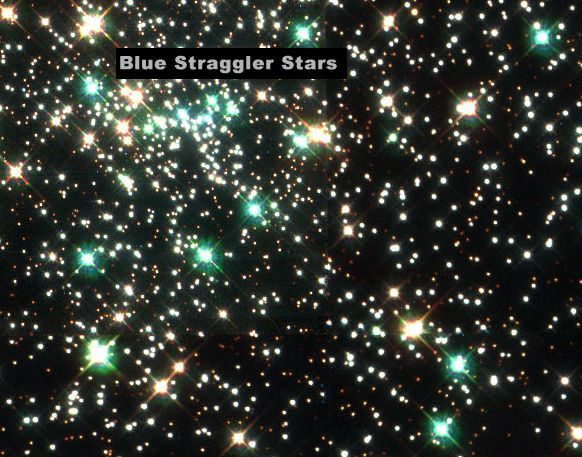
|
Explanation: In our neck of the Galaxy stars are too far apart to be in danger of colliding, but in the dense cores of globular star clusters star collisions may be relatively common. In fact, researchers have evidence that the row of six closely spaced blue stars just below the label in this Hubble Space Telescope image were formed when stars directly collided. Pictured is the central region of NGC 6397, a globular cluster about 6,000 light-years distant, whose stars all formed at about the same time. NGC 6397's massive stars have long since evolved off the main sequence, exhausting their central supplies of nuclear fuel. This should leave the cluster with only old low mass stars; faint red main sequence stars and brighter blue and red giants. However, spectroscopic data show that the indicated stars, descriptively dubbed blue stragglers, are clearly main sequence stars which are too blue and too massive to still be there. Suggestively the stragglers appear to be two and occasionally three times as massive as the lower mass cluster stars otherwise present, supporting evidence for their formation from two and even three star collisions.
|
January February March April May June July August September October November December |
| ||||||||||||||||||||||||||||||||||||||||||||||||
NASA Web Site Statements, Warnings, and Disclaimers
NASA Official: Jay Norris. Specific rights apply.
A service of: LHEA at NASA / GSFC
& Michigan Tech. U.
Based on Astronomy Picture
Of the Day
Publications with keywords: colliding galaxies - stellar evolution - blue stragglers - NGC 6397 - HST
Publications with words: colliding galaxies - stellar evolution - blue stragglers - NGC 6397 - HST
See also:
- APOD: 2025 May 7 Á Galaxy Wars: M81 versus M82
- APOD: 2024 July 30 Á Arp 142: Interacting Galaxies from Webb
- APOD: 2023 September 25 Á Arp 142: The Hummingbird Galaxy
- APOD: 2023 January 23 Á The Colliding Spiral Galaxies of Arp 274
- Galaxy Wars: M81 and M82
- NGC 1316: After Galaxies Collide
- NGC 4676: When Mice Collide
